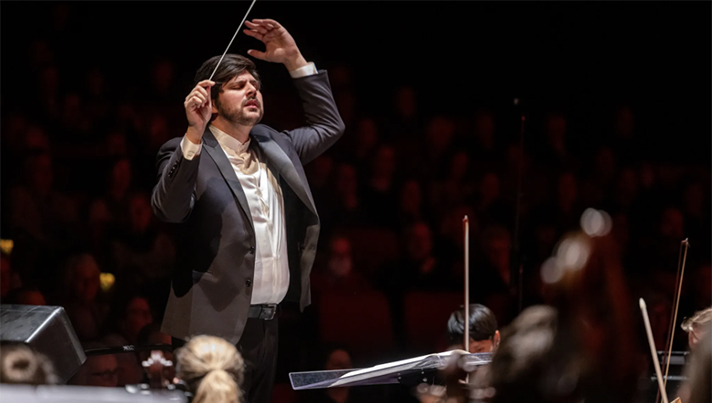Our Playlist column features music curated by our faculty, students, and staff and focusing on an interesting idea or theme. In this column, Prof. Alexander Fisher, a musicologist and Early Music specialist, shares comforting and uplifting music from 17th-century Europe.
When we are living through challenging times like these, music always provides something of a salve. Many of us are at home behind closed doors and wondering what the future holds, looking out the window at these sunny spring days which seem to provide a measure of hope. And with our normal routines upended, we can also turn to music to provide comfort.
Scroll to view the full playlist, or open in Spotify
For many centuries music has provided a vehicle for us to express grief, but also experience the promise of comfort and joy. This was certainly true in Germany during the 17th century, a time of massive dislocation and social upheaval. By the time the Thirty Years War broke out in 1618, Germany was already experiencing an economic downturn, worsened by outbreaks of disease; but the onset of the religious wars led to a period of incredible suffering. Germans of all religious stripes, but especially the Lutherans, turned to devotional prose, poetry, and music to convey the depths of human suffering and to gain some measure of comfort in the hope of eternal redemption.
I put together this playlist to share with you some of my favourite pieces and recordings from this period, starting with Heinrich Schütz and ending with Johann Sebastian Bach, in the hopes that you might also experience the depth of feeling and comfort that this music embodies.
Tracks 1-9: Heinrich Schütz, Musikalische Exequien, La Chapelle Royale, Philippe Herreweghe. Harmonia Mundi.
This is the album that launched my own interest in early music more than thirty years ago as a first-year university music student. The first part of the album contains Heinrich Schütz’s funeral music (1636) for a local nobleman and patron, Heinrich Posthumus von Reuss. Before his death the prince specified the biblical texts that should be engraved on his coffin, and Schütz set these to music in a careful and systematic way. This Musikalische Exequien is organized as a Mass with a German versions of the Kyrie (“Lord have mercy”) and Gloria (“Glory be to God in the highest”), surrounded by a series of biblical commentaries or “tropes” that reflect on the brevity of life, the certainty of death, and the promise of eternal life. Especially moving is the final cantlcle of Simeon, “Herr, nun lässest du deinen Diener in Friede fahren” (Lord, now let thy servant depart in peace), scored with an additional chorus of two angelic Seraphim (sopranos) and a “Blessed soul with the Seraphim” (bass), surely voice of the departed prince himself, singing “Blessed are the dead who die in the Lord”.
This recording is a classic example of Herreweghe’s supple and carefully shaped sound, drawn from a superb cast of singers. There is darkness, depth, and majesty here, an absolute delight throughout. A favourite moment: the opening of “Herr, nun lässest du” (track 3) as the choir enters with the words “in Friede” (“in peace”). The cover art features Hans Baldung Grien’s haunting The Three Ages of Man and Death, which hangs in the Prado.
Track 10: Heinrich Schütz, “Fili mi, Absalon”, from Symphoniae Sacrae, Book 1 (1629), Weser-Renaissance Bremen, Manfred Cordes. CPO.
As a sackbut player this piece is very close to my heart. Schütz sets a short text from the second book of Samuel in which King David laments the death of his son Absalom, who had risen in revolt against him; David wails in grief and wishes he could have died in his son’s place. Surely influenced by the example of Monteverdi’s laments, Schütz scores the piece for solo bass and four sackbuts, which lend the piece a majestic, funereal sound. Although the tempo here is slightly fast for my taste (compare Concerto Palatino’s recording, sadly not on Spotify), Harry van der Kamp’s performance is hard to beat.
Track 11: Matthias Weckmann, “Wie liegt die Stadt so wüste”, Cantus Cölln, Konrad Junghänel. Harmonia Mundi.
With our emptied streets around us, it is difficult to think of a more fitting text set to music than “Wie liegt die Stadt so wüste, die voll Volks war” (How desolate lies the city that was once full of people), a vocal concerto for solo soprano, solo bass, and strings by Matthias Weckmann (c. 1616-1674). Like many cities around the world today, Weckmann’s city of Hamburg was wracked by devastating disease when he wrote this and several other pieces in 1663, seemingly in expectation of an imminent death (luckily, Weckmann would live for another decade).
The soprano and bass sing texts drawn from the Lamentations of Jeremiah, and, as Christina Hutten has suggested, Weckmann has disposed the texts in such a way that the abandoned city of Jerusalem seems to become the plague-benighted city of Hamburg, the voice of the prophet Jeremiah becoming that of Weckmann himself. This collection of pieces concluded with a setting of “In te Domine speravi” (Lord, I have hoped in you), suggesting Weckmann’s affirmation of faith in the face of an epidemiological disaster.
Track 12: Johann Jakob Froberger, Lamentation on the very sad death of His Imperial Majesty, Ferdinand III. Gustav Leonhardt (harpsichord). Harmonia Mundi.
A spectacular and moving example of the French-inspired “tombeau”, a work of lamentation composed at the death of a highly-placed person. In this case it was Froberger’s patron, the Emperor Ferdinand III, who had led the Habsburg empire through the futile final phases of the Thirty Years War and died in 1657. Froberger (1616-1667) specialized in music for keyboard instruments, and is notable for writing highly expressive and programmatic works. Inspired by the broken melodic style of French lutenists, Froberger’s Lamentation is scored in the dark and difficult key of F-minor, and is filled with expressive dissonance.
Tracks 13-14: Dieterich Buxtehude, Fried- und Freudenreiche Hinfarht, BuxWV 76. Netherlands Bach Society, Jos van Veldhoven (dir.). Channel Classics.
The Fried- und Freudenreiche Hinfarth (A Departure Rich in Peace and Joy) is one of only two works that the famous Lübeck organist Dieterich Buxtehude (1637-1707) published during his lifetime. It is a funeral work for the death of his father Johann in 1674, and falls into two parts. The first is a setting of the Lutheran chorale Mit Fried und Freud ich fahr dahin (I depart with peace and joy), which in turn paraphrases the same Canticle of Simeon arranged by Schütz in his Musikalische Exequien.
Buxtehude originally composed this music for superintendent of his church, Menno Hanneken, a few years earlier, but now rededicated it to his father. It features deliberate contrapuntal artifices, with a four-part scoring that might have been intended either for organ or strings (this recording features strings). The second part is a dramatic “Klag-Lied” (song of lamentation), written in the more modern idiom of the strophic aria.
Track 15: Heinrich Ignaz Franz von Biber, Passacaglia for solo violin, from Biber, Violin Sonatas. Romanesca, featuring Andrew Manze. Harmonia Mundi.
The famous violinist Heinrich Ignaz Franz von Biber (1644-1704) added this remarkable work to end of his collection of “Mystery” or “Rosary” Sonatas for solo violin (completed about 1676). In contrast to the rest of the Lutheran-heavy music on this playlist, Biber’s sonatas were likely intended for Catholic Rosary devotions in Salzburg. Many of the sonatas feature so-called “scordatura” tuning, where the violinist is required to retune the strings on their instrument, allowing certain notes to sound on open strings.
This passacaglia may have been intended to be heard on the feast day of the Guardian Angel, and is preceded in the manuscript by a woodcut image depicting the Guardian Angel with a child. But the 65 statements of a descending fourth (G – F- E-flat – D) are strongly reminiscent of the “lamento” tradition in 17th-century Italian and French music, and puts this piece into dialogue with some of the other somber music on our list. A touching and virtuosic performance here from Andrew Manze, one of the modern masters of the baroque violin.
Tracks 16-23: Johann Sebastian Bach, cantata BWV 106, Gottes Zeit ist die allerbeste Zeit. English Baroque Soloists, Monteverdi Choir, John Eliot Gardiner. SDG.
The dark, rich sound of violas da gamba at the opening, soon joined by a pair of recorders, immediately suggests a funereal context for this early cantata or “Actus tragicus” by Bach, likely written in 1707 at the death of a close family member. The opening chorus, “God’s time is the very best time,” is a reminder of God’s providence in life or death. A bass “aria” commands the listener to put their house in order, followed by a strict fugal quartet on the inevitability of death. But the soul (“Into thy hands I entrust my spirit”) places its trust in Jesus, who responds in person (“Today you will be with me in paradise”). A joyful concluding chorale and choral fugue underlines the progression from darkness to light, and shows off Gardiner’s virtuosic singers.
Tracks 24-34: Johann Sebastian Bach. motet Jesu, meine Freude, BWV 227. Collegium Vocale Gent, Philippe Herreweghe. CP.
This is by the far the most expansive and solemn of Bach’s handful of motets, which are sacred pieces for choir without obbligato instruments. Many were written for funerals. The eleven movements, all based on the Lutheran chorale “Jesus, my joy”, are arranged by Bach in a symmetrical fashion around the central fugue, “But you are not of the flesh, you are of the spirit”. Despite the lack of independent instruments, Bach gives a distinctive character to each of the movements, constantly varying the vocal scoring and musical style: nevertheless, the essential character of the chorale persists throughout. Another beautifully shaped performance by Herreweghe.
Tracks 35-45: Johann Sebastian Bach, cantata BWV 21, Ich hatte viel Bekümmernis. La Chapelle Royale, Philippe Herreweghe. Harmonia Mundi.
Bach wrote this large-scale cantata in two halves at Weimar court around 1714, and revived it soon after arriving in Leipzig in 1723. It is one of his finest examples of darkness giving way to light and is an excellent way of concluding this playlist. A dissonant opening sinfonia is followed by a highly introspective and rhetorical chorus that sums up the journey to come: “I had much grief in my heart; but Your consolations revive my soul,” a dark, lugubrious fugue giving way to quick, bright counterpoint.
The first part of the cantata is filled with imagery of flowing tears and sighs, but these are shunted aside in the second half: the key moment is a love recitative and duet between the soul (soprano) and Jesus (bass). The final chorus, “The Lamb that was slain is worthy to receive power and riches and wisdom and strength and honour and praise and glory,” overflows with royalist pomp: the trumpets and drums were added by Bach’s son Wilhelm Friedemann much later, but they give the ending a spine-tingling frisson. Enjoy!


